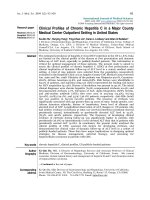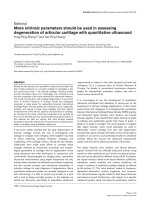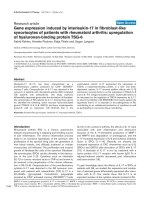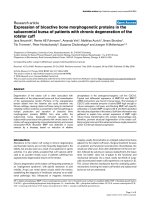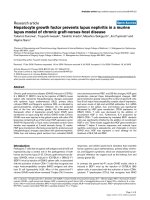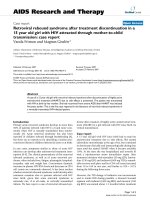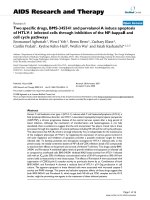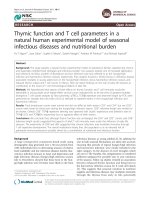Báo cáo y học: "Retroviral rebound syndrome after treatment discontinuation in a 15 year old girl with HIV attracted through mother-to-child transmission: case report" doc
Bạn đang xem bản rút gọn của tài liệu. Xem và tải ngay bản đầy đủ của tài liệu tại đây (360.12 KB, 3 trang )
BioMed Central
Page 1 of 3
(page number not for citation purposes)
AIDS Research and Therapy
Open Access
Case report
Retroviral rebound syndrome after treatment discontinuation in a
15 year old girl with HIV attracted through mother-to-child
transmission: case report
Vanda Friman and Magnus Gisslén*
Address: Department of Infectious Diseases, the Sahlgrenska Academy at Göteborg University, Sweden
Email: Vanda Friman - ; Magnus Gisslén* -
* Corresponding author
Abstract
A case of a 15 year old girl with retroviral rebound syndrome after discontinuation of highly active
antiretroviral treatment (HAART) due to side effects is presented. The patient was transmitted
with HIV at birth by her mother. She had recovered from severe AIDS after HAART was initiated
five years earlier. This is the first case reported in the literature of retroviral rebound syndrome in
a vertically transmitted HIV-infected patient.
Introduction
Primary acute retroviral syndrome develop in more than
50% of patients infected with HIV [1,2] and more com-
monly when HIV is sexually transmitted than intrave-
nously [3]. Acute retroviral syndrome has also been
reported in children infected through breastfeeding [4],
but there are no reports so far describing a similar sero-
conversion illness in children infected in utero or at birth.
In rare cases, symptoms similar to those of acute HIV
infection can develop after antiretroviral treatment inter-
ruption [4-9]. The clinical presentations of this retroviral
rebound syndrome, as well as of acute retroviral syn-
drome, often include fever, fatigue, pharyngitis, lymphad-
enopathy, rash and weight loss. Concomitant dramatic
increases in plasma HIV RNA levels and decreases in CD4
cell counts are commonly observed. It has been unclear
whether retroviral rebound syndrome could develop after
treatment cessation also in patients infected with HIV
since birth, given that acute retroviral syndrome is
extremely rare, if at all exists, in vertically transmitted
infants. We here report a case of retroviral rebound syn-
drome after cessation of highly active antiretroviral treat-
ment (HAART) in a girl infected with HIV since birth via
vertical transmission.
Case report
A 15 year old girl with HIV since birth had to stop her
antiretroviral treatment due to side effects. She started
zidovudine monotherapy at the age of six, but continued
to deteriorate clinically and immunologically during four
years until she started HAART when it became available
1996. At the time she was hospitalized and severely ill
with a Mycobacterium avium intracellulare sepsis. After
treatment initiation with stavudine (30 mg QD), lamivu-
dine (150 mg QD) and indinavir (600 mg TID) a remark-
able recovery took place and her CD4-cell count increased
from 10 to 410 in one year, and further to 920 × 10
6
/L
during the following three years.
However, the TID dosage of indinavir was inconvenient
and to render BID dosing possible, a ritonavir boosted
regimen with indinavir (800 mg BID) and ritonavir (100
mg BID) was started about 1.5 months before treatment
Published: 23 February 2007
AIDS Research and Therapy 2007, 4:3 doi:10.1186/1742-6405-4-3
Received: 9 January 2007
Accepted: 23 February 2007
This article is available from: />© 2007 Friman and Gisslén; licensee BioMed Central Ltd.
This is an Open Access article distributed under the terms of the Creative Commons Attribution License ( />),
which permits unrestricted use, distribution, and reproduction in any medium, provided the original work is properly cited.
AIDS Research and Therapy 2007, 4:3 />Page 2 of 3
(page number not for citation purposes)
cessation. It was not known at that time (2001) that such
high indinavir dosage very often resulted in nephrotoxic
side effects, and the serum creatinine concentration
increased from 59 to 132 μmol/L after the change. Conse-
quently, her antiretroviral treatment was stopped and the
creatinine concentration normalized again within two
months.
Twelve days after the treatment discontinuation she pre-
sented with fever (39–39.5°C), lymphadenopathy,
splenomegaly and abundant sweating during the nights.
Her physical examination was normal and a chest radiog-
raphy showed clear lung fields. Besides confirmed
enlargement of the spleen, nothing abnormal was found
with ultrasound or CT-scan of the abdomen. Blood cul-
tures for bacteria, including mycobacteria, were negative.
Serological testing for Epstein-Barr Virus (EBV), CMV and
toxoplasmosis did not give any evidence of an ongoing
infection. Routine laboratory showed discrete leucopenia
and thrombocytopenia and slightly increased hepatic
aminotransferase levels. Serum lactate and C-reactive pro-
tein were normal. Two weeks after treatment interruption
the plasma HIV RNA level had increased from <50 copies/
mL to >750000 copies/mL and the CD4 cell count
decreased from 770 to 210 × 10
6
/L, figure 1.
Treatment with stavudine (30 mg BID), lamivudine (150
mg BID) and efavirenz (600 mg QD) was re-started just
over one months after cessation, resulting in decreased
HIV RNA and increased CD4 cell count again. The fever
disappeared a few days before treatment was re-initiated.
Discussion
Retroviral rebound syndrome has been described in sev-
eral reports after discontinuation of successful antiretrovi-
ral treatment in patients with chronic HIV infection [5-9].
To our knowledge, this is the first description of this syn-
drome in a patient infected with HIV since birth. The clin-
ical picture with mononucleosis-like symptoms, together
with typical laboratory findings and profound rapid viral
rebound reinforce the diagnosis. Retroviral rebound syn-
drome is a diagnosis of exclusion and syphilis, CMV and
EBV-infections are important differential diagnosis. Sero-
logical analyses did, however, not give support to those
infections in this case. Also other diseases with influenza-
like symptoms may be considered as differential diag-
noses to retroviral rebound syndrome, and although
unlikely, another infection couldn't completely be
excluded in our case.
The clinical presentation of retroviral rebound syndrome
is mostly mild, although more severe manifestations have
Changes in plasma HIV RNA and CD4 cell count before, during, and after antiretroviral cessationFigure 1
Changes in plasma HIV RNA and CD4 cell count before, during, and after antiretroviral cessation. Times on antiretroviral ther-
apy (ART) and period of retroviral rebound syndrome (RRS) symptoms indicated.
Publish with BioMed Central and every
scientist can read your work free of charge
"BioMed Central will be the most significant development for
disseminating the results of biomedical research in our lifetime."
Sir Paul Nurse, Cancer Research UK
Your research papers will be:
available free of charge to the entire biomedical community
peer reviewed and published immediately upon acceptance
cited in PubMed and archived on PubMed Central
yours — you keep the copyright
Submit your manuscript here:
/>BioMedcentral
AIDS Research and Therapy 2007, 4:3 />Page 3 of 3
(page number not for citation purposes)
been described [7,9]. A dramatic rapid loss of peripheral
CD4 cells was seen in our case and an increased risk for
disease progression and serious illness have been shown
in larger studies after structured treatment interruptions
[10]. Thus, but also due to the risk of antiretroviral resist-
ance development, structured treatment interruption
strategies are not options to be used in the clinical setting.
However, there are situations where cessation of treat-
ment is inevitable, as for example by reason of severe side
effects.
This case shows that retroviral rebound syndrome can
develop after cessation of successful antiretroviral treat-
ment also in patients infected with HIV since birth.
Competing interests
The author(s) declare that they have no competing inter-
ests.
Authors' contributions
VF and MG contributed to the patient care, data interpre-
tation, and writing of the paper.
References
1. Lange JM, Parry JV, de Wolf F, Mortimer PP, Goudsmit J: Diagnostic
value of specific IgM antibodies in primary HIV infection. Aids
1988, 2(1):31-35.
2. Schacker T, Collier AC, Hughes J, Shea T, Corey L: Clinical and epi-
demiologic features of primary HIV infection. Ann Intern Med
1996, 125(4):257-264.
3. Sinicco A, Fora R, Sciandra M, Lucchini A, Caramello P, Gioannini P:
Risk of developing AIDS after primary acute HIV-1 infection.
J Acquir Immune Defic Syndr 1993, 6(6):575-581.
4. Rouet F, Elenga N, Msellati P, Montcho C, Viho I, Sakarovitch C,
Danel C, Rouzioux C, Leroy V, Dabis F: Primary HIV-1 infection
in African children infected through breastfeeding. Aids 2002,
16(17):2303-2309.
5. Colven R, Harrington RD, Spach DH, Cohen CJ, Hooton TM: Retro-
viral rebound syndrome after cessation of suppressive
antiretroviral therapy in three patients with chronic HIV
infection. Ann Intern Med 2000, 133(6):430-434.
6. Daar ES, Bai J, Hausner MA, Majchrowicz M, Tamaddon M, Giorgi JV:
Acute HIV syndrome after discontinuation of antiretroviral
therapy in a patient treated before seroconversion. Ann Intern
Med 1998, 128(10):827-829.
7. Garlin AB, Sax PE: Retroviral rebound syndrome with fatal out-
come after discontinuation of antiretroviral therapy. Clin
Infect Dis 2005, 41(9):e83-5.
8. Kilby JM, Goepfert PA, Miller AP, Gnann JW Jr., Sillers M, Saag MS,
Bucy RP: Recurrence of the acute HIV syndrome after inter-
ruption of antiretroviral therapy in a patient with chronic
HIV infection: A case report. Ann Intern Med 2000,
133(6):435-438.
9. Zavascki AP: Severe acute hepatitis due to retroviral rebound
syndrome after discontinuation of highly active antiretrovi-
ral therapy. J Infect 2006, 52(3):e93-4.
10. Julg B, Goebel FD: Treatment interruption in HIV therapy: a
SMART strategy? Infection 2006, 34(3):186-188.
